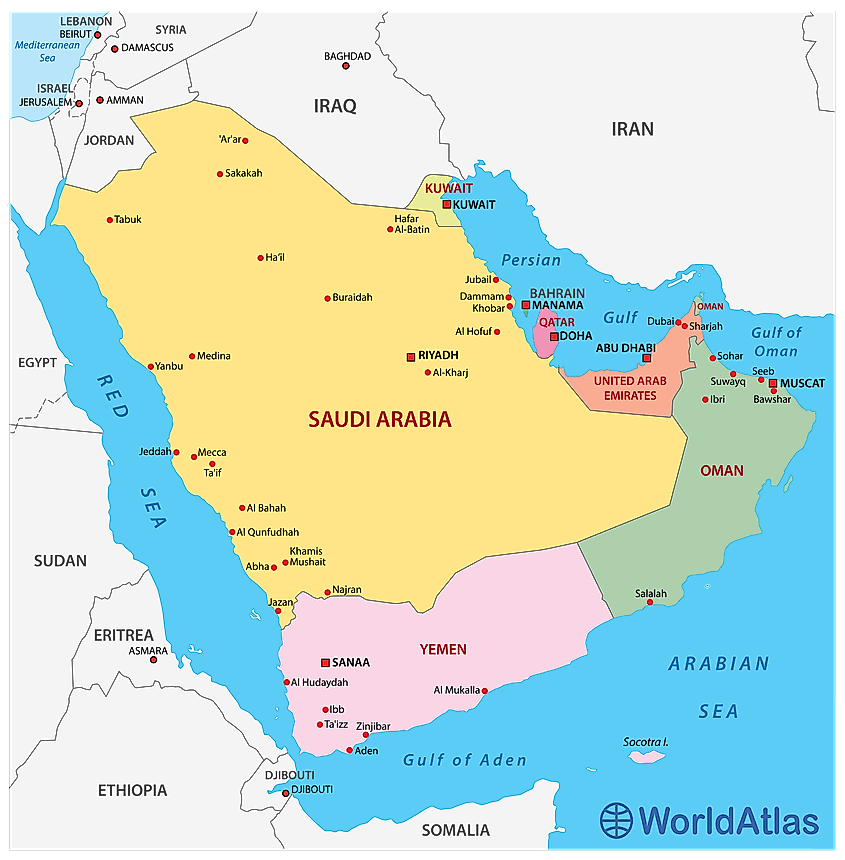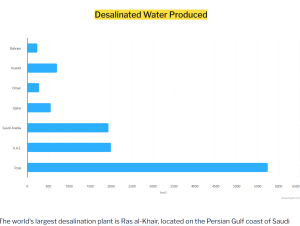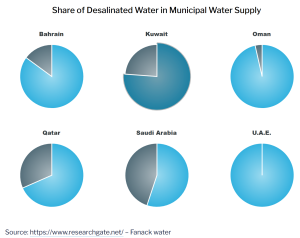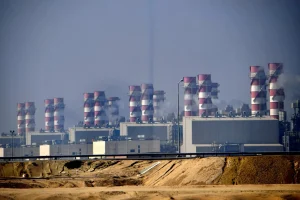
Discover how the Persian Gulf plays a pivotal role in freshwater production for surrounding Arab nations through advanced maritime technologies like reverse osmosis and freshwater generators. Explore challenges, innovations, and real-world applications in this comprehensive guide.
Why the Persian Gulf Matters in Freshwater Provision
In one of the most arid regions of the world, where rainfall is scarce and natural freshwater resources are minimal, the Persian Gulf has become a lifeline. For countries such as Saudi Arabia, the United Arab Emirates, Kuwait, Bahrain, and Qatar, the ability to extract fresh water from the saline sea is not just a technological triumph—it is a matter of survival.
The Persian Gulf’s waters are harnessed using advanced maritime technologies, particularly reverse osmosis (RO) and marine-based freshwater generators, to supply millions with potable water. With increasing populations, climate change, and industrial demands, understanding this system is critical to sustainable development and maritime engineering in the region.
Key Technologies Driving Freshwater Generation in the Persian Gulf
Reverse Osmosis Desalination
Reverse osmosis (RO) is the cornerstone of desalination in the Persian Gulf. In this process, seawater is pushed through semipermeable membranes at high pressure, removing salt and impurities. The result is clean, potable water.
-
Recent Advancements: Over the last 5 years, countries like the UAE have invested heavily in energy-efficient membranes, advanced pre-treatment processes, and AI-driven monitoring systems to optimize performance.
-
Case in Point: Dubai Electricity and Water Authority’s (DEWA) new solar-powered RO plant is expected to produce 120 million gallons of water per day by 2030.
Marine Freshwater Generators
Onboard ships and offshore platforms, freshwater generators use waste engine heat to distill seawater. This method is common in maritime applications and contributes significantly to offshore freshwater supply chains.
-
Types: Low-pressure evaporators, plate-type evaporators, and multi-effect distillation systems.
-
Manufacturers: Notable providers include Alfa Laval, Wärtsilä, and Atlas Copco.
Hybrid Desalination Systems
Many Gulf countries now employ hybrid systems combining thermal and membrane technologies to reduce energy consumption and improve efficiency, particularly in high-salinity waters such as the Persian Gulf.
GCC Water Overview: Reliance on the Persian Gulf for Freshwater
The countries bordering the Persian Gulf—particularly those within the Gulf Cooperation Council (GCC)—face some of the harshest water scarcity challenges on Earth. With some of the lowest annual rainfall and highest evaporation rates globally, the Persian Gulf region is uniquely dependent on alternative sources of freshwater.
Saudi Arabia, the largest country in the region and the world’s largest nation without rivers or natural freshwater bodies, receives less than 150 millimetres of rain annually. Compounding this issue is its evaporation rate, which exceeds 95%, dramatically reducing the availability of surface water.
Despite these harsh natural conditions, water consumption per capita in the GCC is among the highest in the world. While Oman records an average daily per capita consumption of 100 litres, this figure escalates sharply in other countries: 265 litres in Saudi Arabia, 300 in the UAE, 330 in Kuwait, 440 in Bahrain, and a staggering 470 litres per person per day in Qatar—far surpassing countries with more abundant water resources.
As populations grow and economic activities intensify, the demand for freshwater will continue to rise. Projections suggest that by 2050, water consumption in the GCC will reach 33 million cubic metres per day, while available storage will trail behind at 25 million. This gap poses a strategic concern for water security in the region. With the population expected to surge past 70 million by mid-century, innovative and sustainable water production becomes not only a necessity but a matter of national resilience.
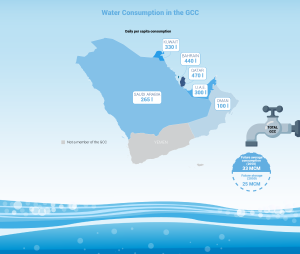
Arab countries – Gulf Cooperation Council (GCC)
Desalination in the GCC: A Dependence Anchored in the Persian Gulf
For decades, desalination has served as the primary solution to the freshwater deficit in the Persian Gulf region. This process—removing salt and minerals from seawater—supports domestic needs as well as industrial and agricultural demands.
Two core technologies underpin desalination across the GCC:
-
Thermal desalination, where seawater is heated and evaporated using energy (often from fossil fuels or solar sources), then condensed into freshwater.
-
Membrane desalination, commonly known as reverse osmosis (RO), which forces seawater through semipermeable membranes that block salt and impurities.
Reverse osmosis has become the dominant technology due to its relatively lower energy consumption and scalability. Most desalination facilities in the Persian Gulf region utilize either reverse osmosis or hybrid systems that combine both methods.
The GCC has emerged as a global leader in desalination, responsible for nearly 40% of the world’s desalinated water production as of 2020—about 97.2 million cubic metres per day. By 2050, this is expected to triple, reaching over 300 million cubic metres daily, with massive public and private investments accelerating this growth.
One of the flagship facilities is the Ras al-Khair plant in Saudi Arabia, strategically located on the Persian Gulf coast. With a daily production capacity of over 1 million cubic metres, it supplies water to major urban centers including Riyadh, highlighting the strategic integration of maritime infrastructure and national water distribution networks.
Governments across the GCC are committing significant resources—an estimated $76 billion in the near term, and over $100 billion by 2027—to bolster desalination capacity, improve infrastructure, and secure long-term water resilience. These investments underscore the Persian Gulf’s centrality to water production and security in the region.
Nuclear and Maritime Pollution in the Persian Gulf: A Looming Catastrophe for Water-Dependent Arab Nations
A massive sea pollution event in the Persian Gulf—such as radioactive contamination from the Bushehr Nuclear Power Plant, the UAE’s Barakah Nuclear Plant, or foreign nuclear-powered aircraft carriers like those of the U.S. Navy—could have catastrophic consequences for Arab nations reliant on desalination. Given that Gulf Cooperation Council (GCC) countries depend on the Persian Gulf for over 90% of their freshwater via reverse osmosis and thermal desalination plants, any large-scale contamination would render seawater unusable, disrupting water supplies for millions. Radioactive or toxic pollutants could damage desalination infrastructure, clog membranes, and pose severe health risks if ingested. With limited freshwater reserves and extreme water scarcity, even a temporary shutdown of desalination plants could trigger a humanitarian crisis, destabilizing societies and economies. The region’s heavy dependence on the Gulf’s waters makes it critically vulnerable to nuclear accidents, industrial spills, or military-related pollution, underscoring the urgent need for stringent environmental safeguards, international cooperation, and contingency planning to mitigate such existential threats.
Challenges and Solutions in Persian Gulf Freshwater Production
Despite its advantages, desalination is not without its drawbacks. The GCC faces several persistent and emerging challenges in managing its reliance on desalinated water sourced from the Persian Gulf.
Environmental Impact
The production of desalinated water generates brine, a highly concentrated salt solution that can severely harm marine ecosystems if not properly managed. Approximately 142 million cubic metres of brine are discharged globally each day, with the Persian Gulf region—especially Saudi Arabia, the UAE, Kuwait, and Qatar—responsible for over half of this total.
This discharge has been associated with reductions in plankton diversity, a foundational component of the marine food web. The ecological ramifications of brine pollution are still under study but are likely to worsen without improved disposal methods and environmental safeguards.
Energy Dependence and Carbon Emissions
Desalination is inherently energy-intensive. The plants depend heavily on fossil fuels, making them major contributors to the region’s carbon footprint. This poses a paradox: the GCC needs desalination to mitigate the effects of climate change-induced water scarcity, yet the process contributes to global warming.
As temperatures in the region rise, so does the demand for cooling and water, creating a feedback loop that exacerbates energy use. This has sparked calls for a transition toward renewable-powered desalination, with solar and wind-powered projects gaining momentum in the UAE and Saudi Arabia.
Infrastructure and Governance
Aging infrastructure and inefficient wastewater treatment systems are also significant barriers. While some countries are beginning to implement advanced water reuse and recycling programs, there remains a long way to go in updating municipal systems and promoting conservation.
Subsidies for electricity and water across the GCC have further complicated reform. These incentives, while politically popular, discourage efficiency and conservation. Water pricing reform, though politically sensitive, is increasingly viewed as essential for long-term sustainability and security.
Key Desalination Challenges in the Persian Gulf and Their Solutions
| Challenge | Details | Solutions / Mitigation Measures |
|---|---|---|
| High Salinity and Temperature | The Persian Gulf has some of the highest salinity levels globally (40–42 PSU), increasing energy demands and accelerating membrane degradation. | – Development of graphene oxide membranes – Forward osmosis pre-treatment technologies |
| Environmental Impact | Desalination produces brine—a concentrated saltwater byproduct—that, when discharged, can harm marine ecosystems. | – Multi-port brine diffusers – Zero Liquid Discharge (ZLD) systems – IMO-compliant environmental regulations |
| Energy Consumption | Conventional desalination relies heavily on fossil fuels, making it carbon-intensive and unsustainable. | – Solar-powered desalination plants – Integration with waste heat recovery – Floating nuclear desalination vessels |
Geopolitical and Strategic Risks of Desalination Dependence
Water security in the Persian Gulf is also deeply intertwined with geopolitical stability. Desalination plants require large amounts of energy, making them vulnerable to disruptions in oil markets or shifts in energy policy. This interdependence means that any regional conflict or diplomatic crisis could threaten the continuous operation of these facilities.
For instance, if a key desalination plant were to be targeted during a conflict or a cyberattack—an increasingly common threat to critical infrastructure—the consequences would be immediate and severe. A shutdown of the Ras al-Khair plant, for example, could leave millions without drinking water within days.
Moreover, marine pollution, whether accidental or deliberate, poses a direct threat to desalination operations. Oil spills in the Persian Gulf, whether from tankers, drilling activities, or accidents, could render seawater temporarily unusable for desalination, leading to severe water shortages.
Photo 1: The Jubail Desalination Plant at the Jubail Industrial City, about 95 kilometres north of Dammam in Saudi Arabia’s eastern province overlooking the Persian Gulf. Source: GIUSEPPE CACACE / AFP
Vulnerability of Gulf Desalination Plants to Iranian Retaliation
The strategic dependence of Arab Gulf states on desalination presents a critical vulnerability that Iran could exploit in the event of escalating hostilities. Given the historical tensions and the potential for conflict in the Persian Gulf, Iranian military or proxy forces may target desalination plants as a form of asymmetric retaliation if Iran perceives aggression from neighbouring Arab states or their allies like the USA.
Potential Iranian Attack Vectors
-
Missile and Drone Strikes – Iran possesses a substantial arsenal of ballistic missiles and drones, which it has used against critical infrastructure in the past (e.g., the 2019 attacks on Saudi oil facilities). Desalination plants, due to their coastal locations and large energy infrastructure, could be high-value targets in a conflict scenario.
-
Cyberattacks – Iran has demonstrated advanced cyber warfare capabilities, including attacks on industrial control systems. A well-coordinated cyber operation could disrupt plant operations, leading to prolonged shutdowns and water shortages.
-
Naval Sabotage and Mining – The Persian Gulf’s narrow waterways make desalination plants susceptible to naval blockades or sabotage. Iran could deploy mines or fast-attack boats to damage intake systems, as seen in past tanker wars.
-
Proxy Attacks – Iranian-backed groups, such as the Houthis in Yemen, have previously targeted Saudi and Emirati infrastructure. A similar attack on desalination facilities could be executed without direct Iranian attribution, complicating retaliation.
Consequences of an Attack
-
Humanitarian Crisis: A successful strike on a major facility like Ras al-Khair (Saudi Arabia) or Jebel Ali (UAE) could deprive millions of water within days, triggering mass displacement and instability.
-
Economic Disruption: Water shortages would paralyze industries, agriculture, and urban centers, compounding economic losses from any broader conflict.
-
Escalation Risks: Such an attack could provoke severe military retaliation, drawing in regional and global powers, including the U.S., and further destabilizing the Gulf.
Case Studies: Real-World Applications
The Ras Al Khair Desalination Plant, Saudi Arabia
One of the world’s largest desalination plants, Ras Al Khair uses a hybrid of MSF (Multi-Stage Flash) and RO technologies to produce over 1 million m³/day. It supports both urban centers and industrial zones in eastern Saudi Arabia.
Floating Desalination Barges – Bahrain
During periods of peak demand, Bahrain deploys floating desalination barges, a concept developed in partnership with Hyundai Heavy Industries. These mobile RO units provide flexible freshwater supply directly from the Gulf.
Abu Dhabi’s AI-Powered RO Networks
In 2023, ADNOC began rolling out an AI-driven system to monitor and optimize RO desalination performance. The system reduced chemical usage by 18% and energy consumption by 12% across multiple facilities.
Future Outlook: Sustainability and Innovation
The push toward net-zero desalination is gaining momentum, particularly after COP28 in the UAE, with initiatives exploring green hydrogen-powered plants and modular offshore desalination units integrated with renewable energy sources like wind and solar. Regulatory bodies such as BIMCO and DNV are playing a key role in shaping sustainable projects. Meanwhile, maritime desalination is evolving, with floating platforms and ships emerging as flexible solutions for emergency relief and mobile infrastructure. Advances in smart ship systems are also enhancing onboard water self-sufficiency, signaling a shift toward more adaptive and eco-friendly desalination technologies.
FAQ: Persian Gulf Fresh Water Production
Q1: Why is desalination so important in the Persian Gulf region?
A1: Due to limited freshwater sources and arid conditions, desalination is critical for domestic, industrial, and agricultural water needs.
Q2: What are the most common desalination methods used?
A2: Reverse osmosis (RO) and multi-stage flash (MSF) distillation are the most widely used techniques.
Q3: How is environmental damage from brine managed?
A3: Technologies like brine diffusers and zero liquid discharge systems help minimize marine pollution.
Q4: Is renewable energy used in desalination?
A4: Yes. Solar-powered RO plants and hybrid systems combining renewables with conventional power are increasingly common.
Q5: What are the biggest technological advancements in desalination?
A5: AI-driven optimization, energy recovery systems, advanced membranes, and modular mobile units are leading trends.
Q6: Who regulates desalination in the Gulf?
A6: National governments, IMO, regional environmental agencies, and classification societies like Lloyd’s Register and BV provide oversight.
Q7: Can ships provide freshwater to coastal regions?
A7: Yes. Mobile desalination vessels and offshore platforms are effective in remote and emergency contexts.
Conclusion
The Persian Gulf is not just a body of water—it’s a strategic resource vital to the sustainability and growth of the Arab world. Through cutting-edge desalination technologies and ongoing innovations, the Gulf countries are overcoming their natural water scarcity. As demand grows and climate pressures intensify, the integration of green energy, AI, and maritime technologies will be central to future resilience.
Water remains an existential issue for the GCC countries, as any geopolitical or economic shift that impacts the operation of desalination plants would jeopardize the survival of millions of people.
Despite the efforts made by Arabs in the Gulf Cooperation Council (GCC) governments to diversify their water supply, desalination plants are the most common and adopted solution to meet the growing water demand. As a result, the high financial and environmental cost could prove unsustainable in the medium and long term.
Although new technologies will allow for more energy-efficient and less environmentally damaging desalination processes, it is highly unlikely that these alone will resolve the region’s chronic water scarcity.
Wasteful lifestyles, water subsidies and low efficiency in water and wastewater management are all factors that could have catastrophic results if not addressed in time.
Implementing policies that will encourage more efficient and responsible water use is the only way to address water shortage in the Gulf efficiently.
Policymakers, maritime engineers, and stakeholders must continue investing in sustainable desalination to ensure that the Persian Gulf remains a beacon of freshwater innovation.
References
- https://water.fanack.com/publications/desalination-miracle-or-false-hope-for-water-scarce-gulf-countries/
- International Maritime Organization (IMO)
- DEWA Official Site – Reverse Osmosis Projects
- Alfa Laval – Marine Freshwater Generators
- Wärtsilä Desalination Systems
- Journal of Desalination (Elsevier)
- United Nations: Water Scarcity in MENA
- DNV – Energy Transition Outlook

